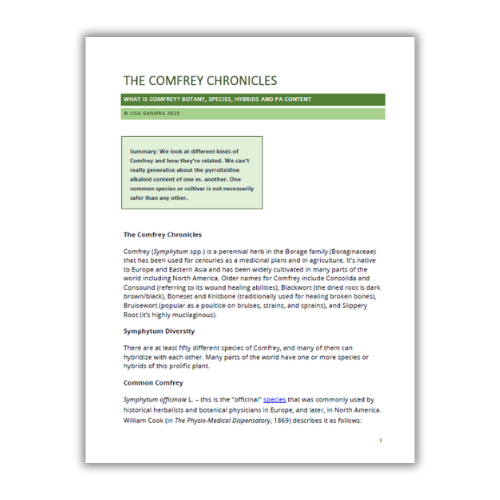
Comfrey & the PA Puzzle
You've heard the opinions - but if you're looking for a comprehensive understanding of the pyrrolizidine alkaloids (PA) in Comfrey (Symphytum), here's your chance to learn from an expert! Join us to develop your understanding of the potential risks, benefits and safety profile of this traditional remedy and its alkaloids. Enroll now to take advantage of this unique opportunity.
ADD TO CARTWhat You'll Discover...
This short course on pyrrolizidine alkaloids (PA) and Comfrey (Symphytum spp.) is designed to provide experienced herbalists, healthcare professionals, pharmacists, and the phytochemically curious with a comprehensive understanding of PA in Western herbs.
We'll dive into their occurrence, structures, properties, metabolism, toxicology, and safety. We'll look at PA in general, and zoom in on those found in Comfrey. We'll also look at the role of Comfrey's polyphenols as possible attenuating synergists - constituents which can decrease the potential toxicity of the PA. Participants will gain an in-depth understanding of the many different kinds of PA, their range of potential toxicities, and the particular form of liver disease (HVOD / HSOS) that can result from excess exposure.
Additionally, we discuss the therapeutic benefits of Comfrey.
We'll discuss traditional dosing, and strategies for minimizing the risk of its PA content by supporting the body's PA metabolism (via glutathione conjugation) and clearance. By the end of this course, participants will be equipped with the knowledge and skills necessary to make a rational risk-benefit analysis of using Comfrey, and to offer professional safety advice to patients, clients, and students.
Watch an introduction from the course creator, Lisa Ganora:
What's Included:

Four Handouts
Featuring in-depth information, illustrations, and links to resources that I have found helpful in understanding the topics. You can read them inside the course any time, or download them to keep forever.

Beautifully-Illustrated PowerPoint Deck
Including photos and phytochemical structures. You are also welcome to download and use it in your classes and presentations!

Fun Self-Assessment Quiz
To check your understanding of the concepts. This quiz is a great learning tool - take it as many times as you want until you know you've got it!

Two 2-Hour Recorded Webinars
Featuring Lisa Ganora, Kat Martello & students where we answer questions, check in on updated research, and expand on the material in the course.
You have lifetime access to all the course materials, and everything is downloadable too.
All of this for only $47 USD.
Why?
We're on a mission to clear up the confusion surrounding this time-honored medicinal plant with this deeply researched, thoughtfully crafted short course that will help you understand the subtleties of The PA Puzzle and empower you to make a well balanced and rational evaluation of Comfrey's benefits and potential risks.
Note: Each country has its own regulations regarding the levels of PA allowable in foods, beverages, and botanical products. Many of these regulations are based on the potential toxicity of the most problematic PA, riddelliine. Although Comfrey does not contain riddelliine and its structural kin (the macrocyclic diesters), regulatory authorities widely consider the herb to be contraindicated for internal use (especially during pregnancy and lactation). However, patterns of traditional use continue throughout many parts of the world, and empirical evidence can contradict the regulatory perspectives.
Disclaimer: This material is intended exclusively for educational purposes and should not be construed as medical advice. Consult your licensed health care provider for individual guidance.


